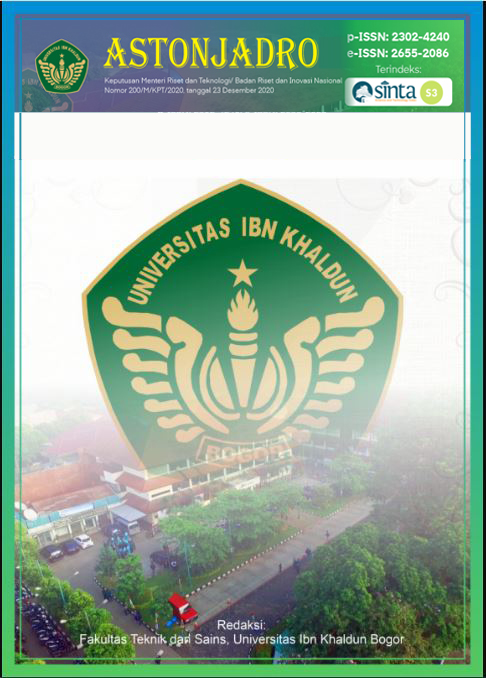Characteristics of Distribution of Heavy Metals in Rivers Around Laterite Nickel Mining Sites in the Tanggetada Area, Kolaka Regency, Southeast Sulawesi Province
DOI:
https://doi.org/10.32832/astonjadro.v12i3.13792Keywords:
heavy metals; mining; nickel laterite; pollution and accidents.Abstract
The research location is located in Tanggetada sub-district, Kolaka district, which is an area very close to laterite nickel mining sites. The determination of the research location was deliberately chosen at the nickel mining location, with the consideration that at that location the river was brownish red, and at that location there were many miners who did not carry out according to mining regulations. The method used is observational which is carried out at nickel laterite mining sites. by using a cross sectional approach that is both qualitative and quantitative. Based on the results of the data analysis that has been carried out, it can be explained that the distribution of heavy metal pollution in river water is the largest in the heavy metal Copper (Cu), namely 0.0108 mg/l, which is found at station 3, heavy metal lead (Pb), namely 0.0070 mg/l l found at station 4, heavy metal chromium (Cr) is 0.0038 found at station 6 downstream, heavy metal Cadmium (Cd) is 0.0028 mg/l found at station 3, heavy metal Hexavalent Chromium (Cr6+) is 0.0026 mg/l found at station 2. From the results of the analysis there are no heavy metals that exceed the quality standard (PP No. 82 of 2001). Meanwhile, the river sediment material produced the greatest amount of heavy metal Copper (Cu), namely 0.0229 mg/kg found at station 2, Heavy metal Cadmium (Cd), namely 0.0128 mg/kg found at station 5, Heavy metal Lead (Pb) namely 0.0177 mg /kg is found at station 1 upstream, heavy metal Chromium (Cr) is 0.0118 mg/kg found at station 6 downstream, heavy metal Hexavalent Chromium (Cr6+) is 0.0116 mg/kg found at station 6 downstream. From the results of this analysis there are no heavy metals that exceed the quality standards (USEPA, 2003).
References
APHA. 2001. Standard Methods for The Examination of Water and Wastewater. Washington: American Public Health Association.
Australian Geoverment. 2016. Pengelolaan keanekaragaman Hayati. Canberra: Australian Geovernment
Arif, irwandy. 2007. Perencanaan tambang total sebagai upaya penyelesaian persoalan lingkungan dunia pertambangan. Manado universitas sam ratulngi.
Darmono. 1995. Logam dalam Sistem Biologi Makhluk Hidup. Penerbit UI. Jakarta.
Darmono.2001 Lingkungan Hidup dan Pencemaran Hubungannya dengan Toksikologi Senyawa Logam. Jakarta: Universitas Indonesia (UI-press); 2001.
Effendy, I., Emiyarti, & A.G. Pratikno. 2021. Akumulasi logam berat timbal (Pb) pada sedimen Teluk Staring Sulawesi Tenggara. Jurnal Ilmu Kelautan Sapa Laut, 6(3): 211-216. https://doi.org/10.33772/jsl.v6i3.2098
Effendi, H. 2003. Telaah kualitas air, Bagi pengelolaan sumberdaya dan lingkungan perairan. Penerbit kanisius. Yogyakarta.
EPA-Ohio. 2001. Sediment Sampling Guide and Methodologies 2nd edition, Environmental Protection Agency, state of Ohio
EPA. 2003. A standardized EPA Protocol for Characterization Indoor Air Quality in Large Office Building
Faiz, M. A., Sufriadin, S. and Widodo, S. 2020. Analisis Perbandingan Kadar Bijih Nikel Laterit Antara Data Bor dan Produksi Penambangan: Implikasinya Terhadap Pengolahan Bijih Pada Blok X, PT. Vale Indonesia, Tbk. Sorowako’, Jurnal Penelitian Enjiniring, 24(1), pp. 93–99. doi: 10.25042/jpe.052020.13.
Hutagalung, H.P., 1984. Logam berat dalam lingkungan laut, Pewarta Ocean. IX, 1, 45–59.
Hutagalung, D.P, D. Setiapermana, dan S.H. riyono. 1997. Metode Analisis Air Laut, Sedimen dan Biota (Buku kedua). P3O LIPI.
Kamarati, K. F. A., Marlon, I. A. and M, S. 2018. Kandungan Logam Berat Besi ( Fe ), Timbal ( Pb) dan Mangan ( Mn ) pada Air Sungai Santan, Jurnal Penelitian Ekosistem Dipterokarpa, 4(1), pp. 50–56.
Muhamad Chaerul, dkk. 2016. Model pecemaran logam berat disetling pond dan sungai pasca penambangan nikel laterit (Disertasi:2016)
Notohadiprawiro, T. 2000. Tanah dan Lingkungan. Pusat Studi Sumber Daya Lahan UGM. 187 hal.
Purwantari N D. 2007. Reklamasi area tailing di pertambangan dengan Tanaman pakan ternak; mungkinkah. Jurnal Wartazoa vol. 17 no. 3 th. 2007
Peraturan pemerintah nomer 78 tahun 2010 tentaang reklamasi dan pascatambang. (2010). Jakarta
Sugiyono. 2018. Metode Penelitian Kuantitatif, Kualitatig, dan R&D, penerbit. Alfabeta,Bandung.
Subowo, Mulyadi, S. Widodo, dan Asep Nugraha. 1999. Status dan Penyebaran Pb, Cd, dan Pestisida pada Lahan Sawah Intensifikasi di Pinggir Jalan Raya. Prosiding, Bidang Kimia dan Bioteknologi Tanah, Puslittanak, Bogor.
Downloads
Published
How to Cite
Issue
Section
License
Copyright (c) 2023 ASTONJADRO

This work is licensed under a Creative Commons Attribution-ShareAlike 4.0 International License.
Paper submitted to ASTONJADRO is the sole property of the Astonjadro Journal. Unless the author withdraws the paper because he does not want to be published in this journal. The publication rights are in the journal Astonjadro.ASTONJADRO
LICENSE
This work is licensed under a Creative Commons Attribution-ShareAlike 4.0 International License.
Based on a work at http://ejournal.uika-bogor.ac.id/index.php/ASTONJADRO













